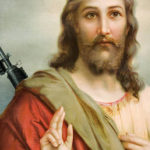We run our website the way we wished the whole internet worked: we provide high quality original content with no ads. We are funded solely by your direct support. Please consider supporting this project.

How the Church is Tempted to “Do Good”
The previous post spoke of God’s call to the church to be resident aliens: a holy, distinct people who are set apart and peculiar when compared to the patterns of the world. The holiness of God’s kingdom is cruciform love, which constitutes our distinct witness to the world. Preserving this holiness and resisting the Devil’s temptation to do good according the patterns of the world is ongoing. When we succumb to Satan’s temptation it only reduces the kingdom of God to another version of the kingdoms of the world.
We are not to be ignorant of this temptation and how it lures us in. Therefore, it is helpful to understand how Jesus himself was tempted to do “good.” The Devil tempted Jesus by offering him all the kingdoms of the world without having to go to the cross (Luke 4:6-8). In essence, the Devil was offering him the very thing he came to get, for Jesus came for the people of the world, and people are always subjects of some kingdom or other. To rule the people, all Jesus had to do was submit to the “god of this age” and leave him in place as its ruling authority.
Without having to suffer and die, Jesus could have immediately taken a position as the functional lord of all these kingdoms. Jesus could have quickly overpowered evil in all societies. He could have immediately alleviated much, if not all, suffering and created a kingdom of the world that enacted perfect law, order, and justice. Not only this, he would have thereby fulfilled all Israel’s expectations of what a messiah was supposed to be.
The Devil’s temptation would not have been a genuine temptation for Jesus unless there was a lot of “good” wrapped up in it. The same is true for us today. However, if Jesus would have taken the course of action offered by Satan, Jesus’ rule would have been part of Satan’s system of domination, which currently runs the world.
Jesus refused this “good” approach. He did not come to make the kingdom of the world a new and improved version of itself. He came to transform “the kingdom of the world” into “the kingdom of our Lord and of his Messiah” and thereby establish the rule of God.
As tempting as it was, Jesus was not going to allow the radical distinctiveness of the kingdom of God to be co-opted by the demonically ruled kingdom of the world—even if the immediate results were “good.” John Howard Yoder once wrote: “The cross is not a detour or a hurdle on the way to the kingdom. It is the kingdom come.” Sacrificial love, therefore, isn’t simply an effective way to make the world a better place, it is the “set apart” kingdom of God on earth! When one obeys God and loves as Christ loves in a kingdom-of-the-world context, it always looks like this.
This is why everything hangs on not allowing it to become co-opted by immediate, obvious, and self-serving kingdom-of-the-world methods, however good the immediate consequences may appear.
—Adapted from The Myth of a Christian Nation, pages 73-75.
Category: General
Tags: Cruciform Theology, Myth of a Christian Nation
Related Reading

Reflections on the Supremacy of Christ (Part 1)
In my previous post I argued that the Bible tells a story in which the culminating event – the coming of Christ – reframes everything that preceded it. Though it is all inspired, not everything in it should carry equal weight for us. Rather, everything leading up to Christ, including the portraits of God, must…

Divine Accommodation and the Cross: where Calvin was onto something
Over the last few posts, I’ve been arguing that the cross represents the thematic center of everything Jesus was about. Hence, rather than striving to have a “Christocentric” theology — which is so broad it means next to nothing—we ought to sharpen our focus by striving for a “cruciform” theology. I then offered some suggestions…

The Centrality of the Cross in Church History
Some readers of Crucifixion of the Warrior God may be assuming that the emphasis I’m placing on the cross is unprecedented in church history. While I will not deny that the cross-centered approached to interpreting Scripture’s violent divine portraits is new, the fact that I’m placing the cross at the center of my understanding of…

How the Anabaptists Emphasized the Cross
Because the Anabaptists have generally emphasized faith that is evidenced by works and thus on Jesus’ life as an example to be followed, it may prima facia appear that the saving work of the cross was less central to the early Anabaptists than it was to the Reformers and to Evangelicals. In reality, I would argue,…

The Problem with Christocentrism
As we’ve discussed in the previous posts, there has been a growing move toward a Christocentric orientation in theology since Barth, and especially over the last fifty years. I enthusiastically applaud this trend, for I’m persuaded it reflects the orientation of the NT itself, so far as it goes. The trouble is, it seems to…

The Cruciform Beauty of Horrific Divine Portraits
“Only a person who is aware of the crucified Christ can properly understand Scripture.” Luther (Table Talks) In the last three posts I’ve been wrestling with how insights from Matthew Bate’s book, The Hermeneutics of the Apostolic Proclamation might help us interpret violent portraits of God in the OT in a way that discloses how…
